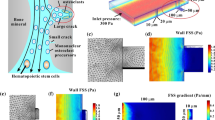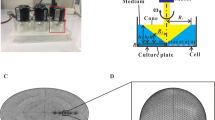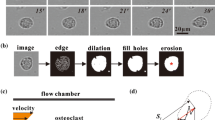Abstract
Intracellular calcium oscillation and its downstream signaling in osteoclasts is believed to play critical roles in regulating bone resorption. Our previous study demonstrated that fluid shear stress (FSS) induced more calcium responsive peaks in the late differentiated osteoclasts than the early ones. In this paper, the signaling pathways of FSS-induced calcium response for the osteoclasts in different differentiation stages were studied. RAW264.7 macrophage cells were induced to differentiate into osteoclasts with the conditioned medium from MC3T3-E1 osteoblasts. Furthermore pharmacological agents were added to block the specific signaling pathways. Finally the cells were exposed to FSS at different levels (1 or 10 dyne/cm2) after being induced for 4 or 8 days. The results showed that the mechanosensitive, cation-selective channels, phospholipase C (PLC) and endoplasmic reticulum constituted the major signaling pathway for mechanical stimulation-induced calcium response in osteoclasts. Extracellular calcium or ATP involved with calcium oscillation in a FSS magnitude-dependent manner. This pathway study may help to give insight into the molecular mechanism of mechanical stimulation-regulated bone remodeling.







Similar content being viewed by others
References
Adinolfi, E., F. Amoroso, and A. L. Giuliani. P2X7 receptor function in bone-related cancer. J. Osteoporos. 2012:637863, 2012.
Batra, N., R. Kar, and J. X. Jiang. Gap junctions and hemichannels in signal transmission, function and development of bone. Biochim. Biophys. Acta 1818(8):1909–1918, 2012.
Bennett, B. D., U. Alvarez, and K. A. Hruska. Receptor-operated osteoclast calcium sensing. Endocrinology 142(5):1968–1974, 2001.
Brandao-Burch, A., et al. The P2X7 receptor is an important regulator of extracellular ATP levels. Front. Endocrinol. (Lausanne) 3:41, 2012.
Combs, C. E., et al. Urocortin is a novel regulator of osteoclast differentiation and function through inhibition of a canonical transient receptor potential 1-like cation channel. J. Endocrinol. 212(2):187–197, 2012.
Everaerts, W., B. Nilius, and G. Owsianik. The vanilloid transient receptor potential channel TRPV4: from structure to disease. Prog. Biophys. Mol. Biol. 103(1):2–17, 2010.
Faccio, R., and V. Cremasco. PLCgamma2: where bone and immune cells find their common ground. Ann. N. Y. Acad. Sci. 1192:124–130, 2010.
Fahlgren, A., et al. Fluid pressure and flow as a cause of bone resorption. Acta Orthop. 81(4):508–516, 2010.
Hazama, R., et al. ATP-induced osteoclast function: the formation of sealing-zone like structure and the secretion of lytic granules via microtubule-deacetylation under the control of Syk. Genes Cells 14(7):871–884, 2009.
Henriksen, Z., et al. The predominant mechanism of intercellular calcium wave propagation changes during long-term culture of human osteoblast-like cells. Cell Calcium 39(5):435–444, 2006.
Hiken, J. F., and T. H. Steinberg. ATP downregulates P2X7 and inhibits osteoclast formation in RAW cells. Am. J. Physiol. Cell Physiol. 287(2):C403–C412, 2004.
Huo, B., X. L. Lu, and X. E. Guo. Intercellular calcium wave propagation in linear and circuit-like bone cell networks. Philos. Trans. A Math. Phys. Eng. Sci. 2010(368):617–633, 1912.
Huo, B., et al. Fluid flow induced calcium response in bone cell network. Cell. Mol. Bioeng. 1(1):58–66, 2008.
Huo, B., et al. An ATP-dependent mechanism mediates intercellular calcium signaling in bone cell network under single cell nanoindentation. Cell Calcium 47:234–241, 2010.
Hwang, S. Y., and J. W. Putney. Orai1-mediated calcium entry plays a critical role in osteoclast differentiation and function by regulating activation of the transcription factor NFATc1. FASEB J. 26(4):1484–1492, 2012.
Ilvesaro, J., and J. Tuukkanen. Gap-junctional regulation of osteoclast function. Crit. Rev. Eukaryot. Gene Expr. 13(2–4):133–146, 2003.
Johansson, L., et al. Bone resorption induced by fluid flow. J. Biomech. Eng. Trans. ASME 131(9):094505, 2009.
Kajiya, H. Calcium signaling in osteoclast differentiation and bone resorption. Adv. Exp. Med. Biol. 740:917–932, 2012.
Kim, K., et al. The transmembrane adaptor protein, linker for activation of T cells (LAT), regulates RANKL-induced osteoclast differentiation. Mol. Cells 33(4):401–406, 2012.
Kuroda, Y., et al. Osteoblasts induce Ca2+ oscillation-independent NFATc1 activation during osteoclastogenesis. Proc. Natl. Acad. Sci. U.S.A. 105(25):8643–8648, 2008.
Lemaire, I., S. Falzoni, and E. Adinolfi. Purinergic signaling in giant cell formation. Front. Biosci. (Elite Ed.) 4:41–55, 2012.
Lev, S., et al. Signal dependent hydrolysis of PI(4,5)P2 without activation of phospholipase C: implications on the gating of the Drosophila TRPL channel. J. Biol. Chem. 287:1436–1447, 2011.
Li, P., et al. Fluid flow-induced calcium response in early or late differentiated osteoclasts. Ann. Biomed. Eng. 40(9):1874–1883, 2012.
Liu, B., et al. Two distinct phases of calcium signalling under flow. Cardiovasc. Res. 91(1):124–133, 2011.
Lu, X. L., et al. Calcium response in osteocytic networks under steady and oscillatory fluid flow. Bone 51(3):466–473, 2012.
Lu, X. L., et al. Osteocytic network is more responsive in calcium signaling than osteoblastic network under fluid flow. J. Bone Miner. Res. 27(3):563–574, 2012.
Masuyama, R., et al. TRPV4-mediated calcium influx regulates terminal differentiation of osteoclasts. Cell Metab. 8(3):257–265, 2008.
Matemba, S. F., A. Lie, and M. Ransjo. Regulation of osteoclastogenesis by gap junction communication. J. Cell. Biochem. 99(2):528–537, 2006.
Mentaverri, R., et al. The calcium sensing receptor is directly involved in both osteoclast differentiation and apoptosis. FASEB J. 20(14):2562–2564, 2006.
Miyazaki, T., et al. Intracellular and extracellular ATP coordinately regulate the inverse correlation between osteoclast survival and bone resorption. J. Biol. Chem. 287(45):37808–37823, 2012.
Mizoguchi, F., et al. Transient receptor potential vanilloid 4 deficiency suppresses unloading-induced bone loss. J. Cell. Physiol. 216(1):47–53, 2008.
Nishii, N., et al. Effects of ATP on the intracellular calcium level in the osteoblastic TBR31-2 cell line. Biol. Pharm. Bull. 32(1):18–23, 2009.
Noh, A. L., et al. L-type Ca(2+) channel agonist inhibits RANKL-induced osteoclast formation via NFATc1 down-regulation. Life Sci. 89(5–6):159–164, 2011.
O’Neil, R. G., and S. Heller. The mechanosensitive nature of TRPV channels. Pflugers Archiv. (Eur. J. Physiol.) 451(1):193–203, 2005.
Reyes, J. P., S. M. Sims, and S. J. Dixon. P2 receptor expression, signaling and function in osteoclasts. Front. Biosci (Sch. Ed.) 3:1101–1118, 2011.
Sakai, H., et al. Phospholipase C-dependent Ca2+-sensing pathways leading to endocytosis and inhibition of the plasma membrane vacuolar H+-ATPase in osteoclasts. Am. J. Physiol. Cell Physiol. 299(3):C570–C578, 2010.
Schilling, A. F., et al. Gap junctional communication in human osteoclasts in vitro and in vivo. J. Cell Mol. Med. 12(6A):2497–2504, 2008.
Son, A., et al. Effects of inositol 1,4,5-triphosphate on osteoclast differentiation in RANKL-induced osteoclastogenesis. Korean J. Physiol. Pharmacol. 16(1):31–36, 2012.
Sukharev, S., and D. P. Corey. Mechanosensitive channels: multiplicity of families and gating paradigms. Sci. STKE 2004(219):re4, 2004.
Thompson, W. R., et al. Association of the alpha(2)delta(1) subunit with Ca(v)3.2 enhances membrane expression and regulates mechanically induced ATP release in MLO-Y4 osteocytes. J. Bone Miner. Res. 26(9):2125–2139, 2011.
Tsuzuki, T., et al. Osmotic membrane stretch increases cytosolic Ca(2+) and inhibits bone resorption activity in rat osteoclasts. Jpn. J. Physiol. 50(1):67–76, 2000.
Wiebe, S. H., S. M. Sims, and S. J. Dixon. Calcium signalling via multiple P2 purinoceptor subtypes in rat osteoclasts. Cell. Physiol. Biochem. 9(6):323–337, 1999.
Wiltink, A., et al. Cell membrane stretch in osteoclasts triggers a self-reinforcing Ca2+ entry pathway. Pflugers Archiv. (Eur. J. Physiol.) 429(5):663–671, 1995.
Xia, S. L., and J. Ferrier. Calcium signal induced by mechanical perturbation of osteoclasts. J. Cell. Physiol. 163(3):493–501, 1995.
Xia, S. L., and J. Ferrier. Localized calcium signaling in multinucleated osteoclasts. J. Cell. Physiol. 167(1):148–155, 1996.
Yasuda, E., et al. Decreased expression of phospholipase C-beta 1 protein in endoplasmic reticulum stress-loaded neurons. Biol. Pharm. Bull. 31(4):719–721, 2008.
Acknowledgment
This work was supported by the National Natural Science Foundation of China [11372043 (BH) and 31070829 (DZ)], National Key Basic Research Foundation of China grant [2011CB710904 (ML)] and the Fundamental Research Funds for the Central Universities [GZ2013015101 (BH)].
Conflict of interest
No conflict of interested is assigned to the manuscript.
Author information
Authors and Affiliations
Corresponding authors
Additional information
Associate Editor Scott I. Simon oversaw the review of this article.
Rights and permissions
About this article
Cite this article
Li, P., Liu, C., Hu, M. et al. Fluid Flow-Induced Calcium Response in Osteoclasts: Signaling Pathways. Ann Biomed Eng 42, 1250–1260 (2014). https://doi.org/10.1007/s10439-014-0984-x
Received:
Accepted:
Published:
Issue Date:
DOI: https://doi.org/10.1007/s10439-014-0984-x




